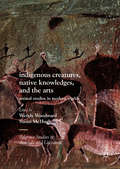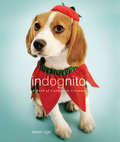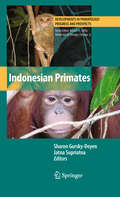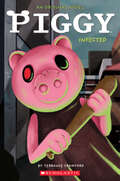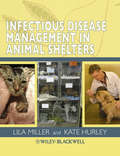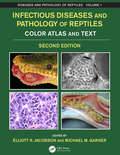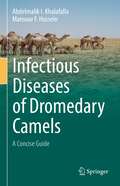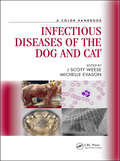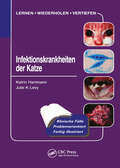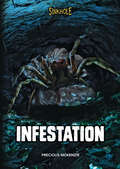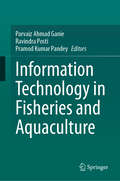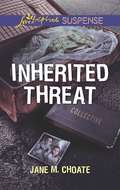- Table View
- List View
Indigenous Creatures, Native Knowledges, and the Arts
by Wendy Woodward Susan MchughThis volume illuminates how creative representations remain sites of ongoing struggles to engage with animals in indigenous epistemologies. Traditionally imagined in relation to spiritual realms and the occult, animals have always been more than primitive symbols of human relations. Whether as animist gods, familiars, conduits to ancestors, totems, talismans, or co-creators of multispecies cosmologies, animals act as vital players in the lives of cultures. From early days in colonial contact zones through contemporary expressions in art, film, and literature, the volume's unique emphasis on Southern Africa and North America - historical loci of the greatest ranges of species and linguistic diversity - help to situate how indigenous knowledges of human-animal relations are being adapted to modern conditions of life shared across species lines.
Indognito: A Book of Canines in Costume
by Karen NgoHilarious, charming, and inventive, INDOGNITO is Karen Ngo's visual treat for today's breed of dog lovers. A whimsical collection of stylishly photographed dog portraits, it affectionately embraces the quirky spirit of the primped pooch. Including humorous quotations, this book is sure to delight and inspire dog-lovers of every age!
Indonesian Primates
by Jatna Supriatna Sharon Gursky-DoyenIndonesia possesses the second largest primate population in the world, with over 33 different primate species. Although Brazil possesses more primate species, Indonesia outranks it in terms of its diversity of primates, ranging from prosimians (slow lorises and tarsiers), to a multitude of Old World Monkey species (macaques, langurs, proboscis moneys) to lesser apes (siamangs, gibbons) and great apes (orangutans). The primates of Indonesia are distributed throughout the archipelago. Partly in response to the number of primates distributed throughout the Indonesian archipelago, Indonesia is classified as the home of two biodiversity hotspots (Wallacea and Sundaland). In order to be classified as a hotspot, an area must have a large proportion of endemic species coupled with a high degree of threat including having lost more than 70% of its original habitat. Two areas within Indonesia meet these criteria. The tremendous diversity of primates in Indonesia, in conjunction with the conservation issues facing the primates of this region, created a need for this volume.
Indoor Cat: How to Enrich Their Lives and Expand Their World
by Laura J. Moss Lynn BahrCan an indoor cat live a happy, stimulating, and active life? A veterinarian and a journalist answer this question with a resounding "yes," and offer real-life guidance for opening up your cat's world, even if they stay within the confines of your home. There are many myths our culture perpetuates about domestic cats: they live longer indoors, sleep all day, are easy and low-maintenance pets, and can't be trained. Even the most well-meaning kitty caregiver will be surprised to learn that these long-held beliefs aren't necessarily based on facts, but instead reflect the many ways we have adapted our feline friends to our indoor, domesticated lifestyles.Indoor Cat, by Laura J. Moss, journalist and founder of Adventure Cats, and Lynn Bahr, a feline-only veterinarian, explores how to help cat owners understand a cat's perspective of their indoor homes, with practical ways to enhance cats' lives to the fullest and combat countless health and behavioral problems that result from indoor living, as well as raising the question: should every cat live exclusively indoors?Together with scientific studies, expert opinions from vets and behaviorists, and firsthand accounts and interviews, this informative and engaging full-color guide strives to reach compassionate cat owners looking for new ways to care for and connect with their feline companions.
Industrial Entomology
by OmkarThis book is a compilation of writings focused on conventional and unconventional insect products. Some of these products are commercials successes, while others are waiting to be launched and are the potential produce of the future. In addition to the well known products honey, mulberry silk, and lac, the book primarily concentrates on silk producing insects other than the mulberry silkworm, insects as food, as sources of medicines, pest and weed managers, and as pollinators. The book highlights the all pervasive role of insects in improving human lives at multiple levels. Accordingly, while most books on insects concentrate on how to limit growth in their population, it instead focuses on how to propagate them. In each chapter, the book brings to the fore how insects are far more beneficial to us than their well publicised harmful roles. This book approaches both unconventional and conventional insect products, such as honey, silk and lac in much more depth than the available literature. It investigates different aspects of the production of these insects, such as the related processes, problems and utilities, in dedicated chapters. Because this book deals with the production of insects or their produce, it has been named Industrial Entomology, perhaps the only book that truly reveals the tremendous potential of insects to help humans live better lives. Based on the research and working experience of the contributors, who are global experts in their respective fields, it provides authentic, authoritative and updated information on these topics. The book offers a unique guide for students, teachers, policy planners, small scale industrialists, and government ministries of agriculture and industry across the globe. It will provide a much required stimulus to insect appreciation and generate enthusiasm for research and the broader acceptance for insect produce. Hopefully, it will also present the Indian perspective on these topics to a global readership.
Infected: An AFK Book (Piggy Original Novel)
by Terrance CrawfordMystery, mayhem -- try to survive the terrifying world of PIGGY in this original novel based on the fan-favorite videogame!There is a mystery to be solved, keys to be found, and an evil pig to escape!Welcome to the bone chilling, pulse-pounding world of PIGGY, the survival-horror game that will keep you up at night. Explore a frightening maze full of secrets to unearth and monsters that are out for blood! Can you make it out alive?
Infection Control in Small Animal Clinical Practice
by Shabbir Simjee Tom Reilly Tim Nuttall Alison Young Lindsey Ashburner Craig R. Breheny Jocelyn Bisson Caitlin Forbes Sian-Marie Frosini Andrew Gardiner Owen Glenn Rosanne Jepson Brandy A. Burgess Rungtip Chuanchuen Martyna Godniak Emily Gorman Eleanor Haskey Thawanrut Kiatyingangsulee Steven Murphy Lucas Pantaleon Kathryn Pratschke Alan D. Radford Mellora Sharman Helen Silver-MacMahon David A. Singleton Katie Smyth Faye Swinbourne Denis Verwilghen Martin L. Whitehead Nicola J. WilliamsInfection prevention and control is vital within a veterinary setting, but can find itself an automated part of care - and therefore vulnerable to time constraints, forgetfulness and routine. This book is written by experts in the field and uses evidence-based findings to elevate infection prevention to a well understood, dynamic concept, relevant to both veterinary practitioners and nurses in practice. Comparing key findings to the human healthcare world, this book: Maximises learning opportunities with lots of practical examples and cases; Provides practical how-to sections, such as setting up a surveillance programme; and Bases findings on current veterinary literature. Beginning with an introduction to the importance of infection control, dedicated chapters in this book then consider key principles such as hand hygiene, personal protective equipment, infection control for the surgical and hospitalised patient, and care for immunosuppressed individuals. Importantly, this book presents an up-to-date exploration of responsible antibiotic use in the context of rising resistance.
Infectious Disease Ecology: Effects of Ecosystems on Disease and of Disease On Ecosystems
by Richard S. Ostfeld Felicia Keesing Valerie T. EvinerGathering thirteen essays by forty leading experts who convened at the Cary Conference at the Institute of Ecosystem Studies in 2005, this book develops an integrated framework for understanding where these diseases come from, what ecological factors influence their impacts, and how they in turn influence ecosystem dynamics. It marks the first comprehensive and in-depth exploration of the rich and complex linkages between ecology and disease, and provides conceptual underpinnings to understand and ameliorate epidemics. It also sheds light on the roles that diseases play in ecosystems, bringing vital new insights to landscape management issues in particular. While the ecological context is a key piece of the puzzle, effective control and understanding of diseases requires the interaction of professionals in medicine, epidemiology, veterinary medicine, forestry, agriculture, and ecology. The essential resource on the subject, Infectious Disease Ecology seeks to bridge these fields with an ecological approach that focuses on systems thinking and complex interactions.
Infectious Disease Management in Animal Shelters
by Dvm Lila Miller Kate Hurley MpvmInfectious Disease Management in Animal Shelters is a comprehensive guide to preventing, managing, and treating disease outbreaks in shelters. Emphasizing strategies for the prevention of illness and mitigation of disease, this book provides detailed, practical information regarding fundamental principles of disease control and specific management of important diseases affecting dogs and cats in group living environments. Taking an in-depth, population health approach, the text presents information to aid in the fight against the most significant and costly health issues in shelter care facilities.
Infectious Disease Management in Animal Shelters
by Lila Miller Stephanie Janeczko Kate F. HurleySince the publication of the first edition of Infectious Disease Management in Animal Shelters in 2009, research and practice in the field of shelter medicine have advanced significantly. This updated second edition of that seminal work provides the most up-to-date and comprehensive guide to preventing, managing, and treating infectious diseases affecting cats, dogs and exotic small companion mammals in animal shelters. Throughout the book, the authors—noted experts on the topic—bridge the gap between medicine (both individual and group) and management. The book is filled with practical strategies that draw on the latest research and evidence-based medicine as well as the authors’ personal experience in the field. While the text highlights strategies for the prevention of illness and mitigation of disease spread, the book also contains practical information on treatment and considerations for adoption. This important text: Offers the only book dedicated to the topic of infectious disease management in shelters Presents guidelines for general management and disease prevention and control in cats and dogs Includes shelter medicine’s core principles of humane population management in the context of supporting shelters’ goals for preserving welfare, saving lives and protecting human health Contains a new chapter on exotic companion mammals Written for shelter veterinarians, managers, and workers, the revised second edition of Infectious Disease Management in Animal Shelters is the only book to focus exclusively on infectious diseases in the shelter setting, blending individual animal care with a unique herd health perspective.
Infectious Diseases and Arthropods (Infectious Disease Ser.)
by Jerome GoddardWith the exception of a few tropical medicine schools worldwide, current medical education programs include almost zero discussion of the interface between infectious diseases and entomology. That is why this book was initially published in the first edition almost 17 years ago. The third edition of this valuable infectious disease entomology book updates all existing chapters with the newest scientific developments described in the medical and entomological literature in addition to covering 10 entirely new topics not addressed in previous editions, which include: · arthropod identification controversies · early beginnings of public health and disease control · red-meat allergy · updates on vaccine development for dengue and malaria · discussion of Chikungunya and Zika viruses · American Boutonnneuse Fever · the newest controversies in Lyme disease · recent findings of viruses in ticks · bed bug bite reactions · Morgellons disease (an imaginary infectious disease)
Infectious Diseases and Pathology of Reptiles: Color Atlas and Text, Diseases and Pathology of Reptiles Volume 1
by Elliott R. Jacobson and Michael M. GarnerInfectious Diseases and Pathology of Reptiles, Second Edition provides definitive information on every aspect of the anatomy, pathophysiology, and differential diagnosis of infectious diseases affecting reptiles. It features stunning high-quality color photos of normal anatomy and histology, as well as gross, light, and electron microscopic images of infectious diseases of reptiles. Editor Elliott Jacobson draws on his own photography collection, and his wealth of experience spanning over 40 years in the research of infectious diseases and veterinary care of reptiles. Already a comprehensive reference, a new volume covering noninfectious diseases of reptiles has now been added to create a two-volume set, Diseases and Pathology of Reptiles. Beginning with a thorough review of the biology, anatomy, and histology of reptiles, Volume 1 covers all major systems and provides the most complete single source for color images of reptile histology, hematology, and cytology. Volume 1 addresses the mechanism of reptile immunology and the response to pathogens, and explains how immunological response is key to differential diagnosis. It provides an overview of electron microscopy, complete with electron micrographs of reptile pathogens, and introduces the necessity of molecular methods for diagnosis. Finally, this volume devotes several chapters to the viral, bacterial, fungal, and parasitic diseases known to reptiles, and methods for isolating these pathogens. With up-to-the-minute data, an array of sharp and high-quality images, and a panel of expert contributors, this new edition of Infectious Diseases and Pathology of Reptiles is the definitive resource for veterinary pathologists, zoo or wildlife veterinarians, and the increasing number of private practice veterinarians seeing reptiles kept as exotic pets. It is also ideal reading for veterinary students specializing in exotics, candidates for ACZM accreditation, and private breeders and hobbyists.
Infectious Diseases of Dromedary Camels: A Concise Guide
by Abdelmalik I. Khalafalla Mansour F. HusseinThis book serves as a comprehensive yet concise reference guide reviewing the latest knowledge on bacterial, viral, fungal and parasitic infectious diseases of old world dromedary camels. Pathogen etiology, clinical manifestations and diagnostic techniques are provided for each pathogen and disease prevention and treatment strategies are discussed.Despite a steady increase in camel husbandry worldwide, the pathologies of camel diseases are still relatively under investigated in comparison to other livestock and companion animals. With an ongoing worldwide prevalence increase, infectious diseases are a constant threat to animal and human health. In recent years dromedary camels have become a focus of increasing public health interest since they have been considered the direct source of zoonotic transmission of MERS-CoV to humans. Along these lines, the book covers topics related to zoonotic infections associated with camels.This book offers a valuable source of information for veterinary clinicians, researchers, graduate students, veterinary technicians and interested laymen.
Infectious Diseases of Wild Mammals and Birds in Europe
by Anna Meredith J. Paul Duff Dolorés Gavier-WidenInfectious Diseases of Wild Mammals and Birds in Europe is a key resource on the diagnosis and treatment of infectious diseases in European wildlife that covers the distinctive nature of diseases as they occur in Europe, including strains, insect vectors, reservoir species, and climate, as well as geographical distribution of the diseases and European regulations for reporting, diagnosis and control. Divided into sections on viral infections, bacterial infections, fungal and yeast infections, and prion infections, this definitive reference provides valuable information on disease classification and properties, causative agents, epidemiology, pathogenesis, and implications for human, domestic and wild animal health.Key features:* Brings together extensive research from many different disciplines into one integrated and highly useful definitive reference.* Zoonotic risks to human health, as well as risks to pets and livestock are highlighted.* Each disease is covered separately with practical information on the animal species in which the disease has been recorded, clinical signs of the disease, diagnostic methods, and recommended treatments and vaccination.* Wildlife vaccination and disease surveillance techniques are described.* Examines factors important in the spread of disease such as changing climate, the movement of animals through trade, and relaxations in the control of wide animal populations.
Infectious Diseases of the Dog and Cat: A Color Handbook
This is a concise and quick reference guide, clinically oriented, based on experience underpinned by published research data. The systems-based approach emphasizes the problem list process utilized by most practitioners when faced with a patient presenting with a single or variety of clinical symptoms. This allows generation of a complete list of infectious disease differentials, and the ability to include or exclude those indicated based on patient risk assessment. Pathogen specific information enables rational choice of diagnostics, therapy, and prognostication for a complete list of small animal infectious disease that includes bacterial, viral, parasitic/protozoal and fungal.
Infectious Diseases of the Horse: Diagnosis, pathology, management, and public health
by J.H. van der Kolk E.J.B. Veldhuis KroezeA clinician and a pathologist collaborate to create a comprehensive yet practical book about established infectious diseases of horses, categorised according to the different pathogens. The book evaluates the latest diagnostic aids, including rapid developments in molecular biology, while emphasising that they are no substitute for clinical observation and skills. The majority of equine infectious diseases caused by microbes and parasites are covered - bacterial, viral, protozoan, fungal, ectoparasitic and helminthic. Practical appendices contain a list of differential diagnoses based on clinical signs to support clinical decision-making, a list of zoonoses and reportable diseases, and an elaborate illustrated appendix on clinical pathology and haematology. Thoroughly updated a decade after the release of the original text, the book continues to be concise and easy to understand and remains an important resource for uncommon conditions. It adds new sections on pythiosis, equine encephalosis/Peruvian horse sickness virus, Acinetobacter baumanii, enteric coronavirus-induced disease, and viral hepatitis, as well as updated nomenclature according to the latest reference databases. The most dynamic changes in veterinary medicine concern the development of new molecular diagnostic techniques and therapies, and these have been updated with most recent references throughout this second edition. Finally, the exceptional, full-colour clinical and microscopic images are showcased in a larger format. Infectious Diseases of the Horse is a valuable resource for all veterinary practitioners, scientists, pathologists, students, technicians and nurses working with horses.
Infectious Tropical Diseases and One Health in Latin America (Parasitology Research Monographs #16)
by Heinz Mehlhorn Jorg HeukelbachThis book covers current aspects of important infectious diseases affecting human and animal health in Latin American countries. Readers are equipped with details on arthropod vectors as well as on neglected health problems. Diseases covered include Neglected Tropical Diseases such as Chagas Disease, schistosomiasis, tungiasis, myiasis and leishmaniasis, but also Zika and Chikungunya viral infections, plague and yellow fever. One focus is given on parasitic transmission routes.In addition, the authors describe current therapeutic options and sustainable control measures, considering both human and animal health. By highlighting options within the interdisciplinary One Health approach, they round off this work into a cutting-edge reference for diverse expert readers. Scientists and clinicians concerned on public health, entomology, tropical medicine and parasitology not only in Latin America will find this collection particularly valuable.Finally, these contributions are essential in the framework of the Sustainable Development Goals and the targets of SDG 3 (Good Health and Well-being) in order to combat and end epidemics of Neglected Tropical Diseases.
Infektionskrankheiten der Katze
by Katrin Hartmann Julie K. LevyDer erste in Deutsch erschienene Band aus der Reihe Veterinary Self-Assessment Colour Review behandelt alle Arten der Infektionskrankheiten der Katze. Er umfaßt Infektionen, die von Viren, Bakterien, Parasiten und Pilzen verursacht werden. Die 199 klinischen Fälle werden wie in der Praxis nach dem Zufallsprinzip präsentiert. Die breite Auswahl der Fälle sorgt dafür, daß alle Organsysteme der Katze vorkommen, die von Infektionen befallen werden. Die illustrierten klinischen Fallbeispiele enthalten in den Text integrierte Fragen und ausführlich erklärte Antworten. Das Buch wendet sich an Ärzte in Praxis und Klinik, an Studenten, HelferInnen und Techniker.
Infestation
by Timothy J. BradleyA contemporary take on the classic creature-feature genre. INFESTATION is a thrilling, fast-paced story that will leave your skin crawling. When Andy Greenwood is sent to the Reclamation School for Boys he expects the lousy food, mean drill sergeant instructors, and brutal bullies. What he doesn't expect is an infestation of weirdly large and aggressive ants, or the itching welts all over the staff and students. Even odder, Andy learns that kids never leave the school when they're supposed to. They just seem to get stuck there indefinitely. Following a ground-splitting earthquake, however, things quickly go from bad to horrifying. The school is overrun by monstrous bugs, and Andy himself comes face to face with mutant ants the size of humans, equipped with pinchers that can cut steel. Trapped in a cinderblock institutional building in the New Mexico desert, miles from civilization, Andy must figure out a way to save himself and the surviving boys from this nightmare.
Infestation (Sinkhole)
by Precious McKenzieIt was supposed to be a year to remember for seniors Sofia Schultz and Carmen Hernandez. But when weird things start happening around Foggy Creek, they quickly realize that it will be a memorable year—if they survive! Strange power surges, a missing cat, spooked horses, and mysterious tracks lead the friends to eerie sinkholes. There, they find giant tarantulas that will feed on everything they can get their hairy legs on. Can Sofia and Carmen stop the mutant creatures?
Infested: How the Bed Bug Infiltrated Our Bedrooms and Took Over the World
by Brooke BorelBed bugs. Few words strike such fear in the minds of travelers. In cities around the world, lurking beneath the plush blankets of otherwise pristine-looking hotel beds are tiny bloodthirsty beasts just waiting for weary wanderers to surrender to a vulnerable slumber. Though bed bugs today have infested the globe, the common bed bug is not a new pest at all. Indeed, as Brooke Borel reveals in this unusual history, this most-reviled species may date back over 250,000 years, wreaking havoc on our collective psyche while even inspiring art, literature, and music—in addition to vexatious red welts. In Infested, Borel introduces readers to the biological and cultural histories of these amazingly adaptive insects, and the myriad ways in which humans have responded to them. She travels to meet with scientists who are rearing bed bug colonies—even by feeding them with their own blood (ouch!)—and to the stages of musicals performed in honor of the pests. She explores the history of bed bugs and their apparent disappearance in the 1950s after the introduction of DDT, charting how current infestations have flourished in direct response to human chemical use as well as the ease of global travel. She also introduces us to the economics of bed bug infestations, from hotels to homes to office buildings, and the expansive industry that has arisen to combat them. Hiding during the day in the nooks and seams of mattresses, box springs, bed frames, headboards, dresser tables, wallpaper, or any clutter around a bed, bed bugs are thriving and eager for their next victim. By providing fascinating details on bed bug science and behavior as well as a captivating look into the lives of those devoted to researching or eradicating them, Infested is sure to inspire at least a nibble of respect for these tenacious creatures—while also ensuring that you will peek beneath the sheets with prickly apprehension.
Infinite Paradise: Witnessing the Wild, a Memoir
by Dianne Ebertt BeeaffExperience a year immersed in the healing power, adventure, and tranquility of the natural world, on sixteen acres of wild land in Southern Ontario, Canada. With personal vignettes and color photographs that track the seasons of a single year, Infinite Paradise connects readers with the wildlife on sixteen acres of forest and water meadow along the Conestoga River in Southern Ontario, Canada. Broken into seasons and then further into months and days, the book focuses on the buoyancy of life, showing readers that in a world battered by global warming, habitat destruction, and species extinction, many riches still remain. Interacting with nature can combat stress, heal the human spirit, and foster new and calming perspectives on life. As Infinite Paradise illustrates, the complexity, beauty, and power of the natural world is available to any reader who stays open to the splendid lifeforms they live among.
Information Technology in Fisheries and Aquaculture
by Pramod Kumar Pandey Parvaiz Ahmad Ganie Ravindra PostiThis book connects information technology (IT) to the fisheries and aquaculture sectors. The topics covered in the book explore the diverse ways in which IT contributes to promoting sustainable practices and efficient management in aquatic environments. From examining current challenges through a technological lens to investigating advanced applications like Internet of Things (IoT), remote sensing and machine learning, the book covers a wide range of themes. The chapters address crucial aspects such as precision nutrition, disease management, environmental monitoring and the economic effects of adopting IT. It also bridges the gap between traditional aquaculture practices and the transformative potential of information technology. This book serves as a reference for researchers, practitioners, policymakers and students in the field of fisheries and aquaculture
Inherited Threat (Mills And Boon Love Inspired Suspense Ser.)
by Jane M. ChoateHazardous Legacy…Her mother’s mistakes have made her a target.After her estranged mother is killed by a crime syndicate, army ranger Laurel Landry knows she’s next…and she needs help from ex-ranger turned bodyguard Mace Ransom. While Mace is used to doing things his way, their best chance of staying alive is relying on each other. Their enemies aren’t backing down…but together Laurel and Mace might be able to stop them for good.
